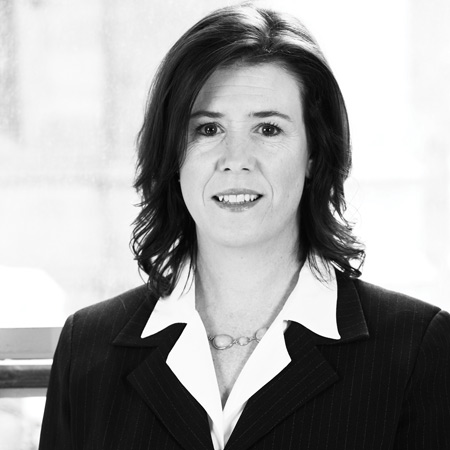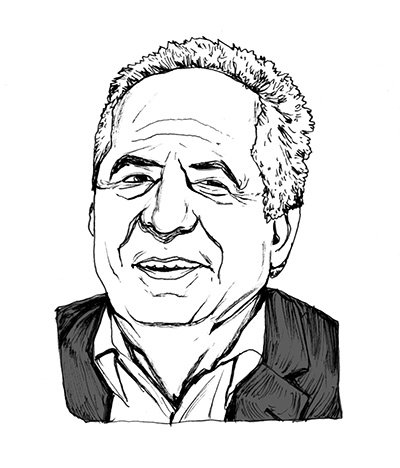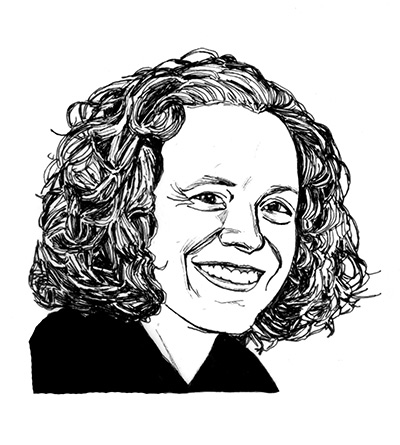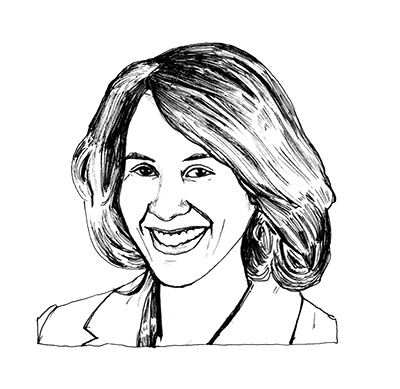By Steve Giegerich and Joe Levine
Teaching has never been for the faint of heart, but today the job demands particular resilience, resourcefulness and commitment to young people. It also requires extensive apprenticeship in classrooms, grounded in deep theory. With the profession at a watershed moment, grappling with shortages and strikes, Teachers College faculty, students and alumni discuss teaching’s challenges, reflect on how TC equips teachers to thrive, and offer ideas for empowering our teachers. This story appears in the spring 2019 issue of TC Today magazine.
[Read Teaching as an Ethical Calling, an essay by David Hansen, TC’s John L. & Sue Ann Weinberg Professor in Historical & Philosophical Foundations of Education.]
Part One: A Changed Landscape
Teaching today requires idealism, optimism and quality preparation — not “training” — to help teachers continue to respond to new challenges in the classroom.
Of all the students she has taught, Raven Hebert has stayed closest with a young man who once disrespected her for being black. Dave (not his real name) used to tell friends, within Hebert’s earshot, that black people lack the intelligence to teach. “I finally took him aside and asked, ‘Do you really believe that?’” recounts Hebert (M.A. ’06), a science teacher at Martin Luther King High School in Riverside, California. “He said, ‘That’s what my father says.’ I said, ‘You’re old enough to form your own opinions. What do you think?’” Dave stopped making offensive comments. Eventually, he made friends with several black and Mexican students and bonded with Hebert.

QUICKENING PACE What’s teaching like? Imagine a party for 20 seven-year-olds. Now you’re with those kids six hours a day, and juggling extra help sessions, parents’ emails, committee assignments, test prep. (Illustration: Gordon Studer)
If only solving racism were that easy. “His friends liked me, so it was partly peer pressure,” Hebert says of Dave’s change of heart. Still, her experience suggests the challenges teachers face — and the impact they can have.
“Teachers are heroes,” says Jeffrey Young, Professor of Practice in TC’s Education Leadership program, and former Superintendent of Schools in Cambridge, Massachusetts. “Doctors save lives, but teachers help to create and shape them. What work could be more valuable?”
Hebert loves her job and hopes to retire as a teacher. But it’s no secret that the profession is in the midst of a crisis. As older teachers retire, younger people aren’t replacing them. A 2016 report by the Learning Policy Institute estimates that teacher demand (defined as annual hires needed) will top 300,000 by 2025 as supply dips under 200,000. In March, The Washington Post reported that in Oklahoma, 30,000 teachers have quit since 2013.
Meanwhile, during just the past two years, teachers have staged strikes and walkouts in West Virginia, Colorado, North Carolina, Oklahoma, Arizona, Kentucky and California.

Reveta Bowers (Photo Credit: Andrew Zinn)
Teaching within Communities
“Other countries revere education and educators,” says Reveta Bowers, TC Trustee and former Head of School at the Center for Early Education in Los Angeles. “We need to invest time, expertise and resources to promote the importance of this profession.” Schools should function as “communities that convene people to learn, celebrate and collaborate on understanding and addressing society’s larger issues.”
“How many years have teachers in these places worked in conditions that no other professionals would tolerate?” asks Young. “Twenty minutes for lunch, no quiet place to make a call or sit. Buying books, buying Skittles for math manipulatives. Scraping by at 2 percent pay raises, if that? It’s like the movie Network. They’re mad as hell, and they’re not gonna take it anymore.”
Certainly teaching salaries vary widely, from a mean of over $82,000 in Alaska and New York to below $43,000 in Oklahoma, Mississippi and West Virginia, where teachers often work extra jobs. But pay isn’t the only issue.
Teachers and administrators say that more students are hampered by emotional and psychological problems, including those linked to poverty, violence, abuse and drugs. Yet teachers are held accountable for — and often evaluated based on — students’ standardized test scores.
“The U.S. is trying to do something unprecedented in its history — maintain excellence with thoroughgoing equity,” says Michael Rebell, Professor of Practice and Executive Director of TC’s Center for Educational Equity. “New York’s Regents say all children must meet challenging academic standards. That’s a noble aspiration, but it doesn’t come cheap.”
With extra help sessions, emails from parents, committee assignments and test prep (which challenges teachers’ creativity to avoid “teaching to the test”) added to evenings preparing lessons and grading assignments, “work outside of class has quadrupled,” says Roberta Lenger Kang (Ed.D. ’15), who directs TC’s Center for Professional Education of Teachers (CPET).
A Bad Rap
Yet perhaps most daunting for many teach.ers is the lack of public affirmation. “Teachers are not treated as knowledgeable and capable,” says Dirck Roosevelt, Associate Professor of Practice. “They feel that disrespect deeply.”
“Other countries revere education and educators,” says Reveta Bowers, TC Trustee and former Head of School at the Center for Early Education in Los Angeles. “In this country, education gets politicized in ways it shouldn’t be. We need to invest focus, time, expertise and resources in order to promote the importance of this profession.”

ON TRACK Beyond their desire to save the world, teachers are powered by quality preparation. Grounding in theory is “what separates teacher preparation from teacher training,” says a TC graduate. (Illustration: Carlo Giambarresi)
Christina Kishimoto (Ed.D. ’02), Superintendent of Hawaii’s public schools, believes teachers have been unfairly subjected to “a discouraging public discourse focused on their failure to solve the ills of society.” Katrina McCombs (M.A. ’96), Superintendent of Schools for Camden, New Jersey, adds that while “learning begins in the womb and at home, the weight falls on teachers to adjust for huge gaps in kids’ early experiences.”
Yet despite these challenges, most teachers are buoyed by idealism, optimism and “a desire to save the world,” says Celia Oyler, Professor of Education — and also by quality preparation, which at Teachers College is founded on the stances of social justice, curriculum and inquiry.
“We affirm three core values in our teacher education programs,” says Kelly Parkes, Associate Professor in the Department of Arts & Humanities, who chairs TC’s Teacher Education Policy Committee. “A deep commitment to meeting the needs of all learners by recognizing their capacities and challenges; preparing teachers to be deliberate and reflective decision-makers; and shaping quality teaching by focusing on content and community.”

Kelly Parkes (Photo Credit: Erick Raphael)
Values to Teach By
“We affirm three core values in our teacher education programs,” says Kelly Parkes, Associate Professor, Department of Arts & Humanities, and Teacher Education Policy Committee chair. “A deep commitment to meeting all learners’ needs by recognizing their capacities and challenges; preparing teachers to be deliberate and reflective decision-makers; and shaping quality teaching by focusing on content and community.” (Photo: Erick Raphael)
Those principles “map the landscape of learning for our teaching students and put experience and theory into context,” says CPET’s Lenger Kang. And in states like New York, they are reinforced by a rigorous teacher certification process. TC’s teacher education programs, for example, “insist that our students spend hundreds of hours in the field — far more than the state requires — under the supervision of cooperating teachers,” says Aimee Katembo, Director of the Office of Teacher Education. The various TC programs currently place about 450 students each semester in the city’s schools, while TC Zankel and Milman Fellows lend their expertise in music, science and other courses at the pre-K–8 Teachers College Community School in West Harlem.
Still other TC initiatives, like the Reimagining Education Institute, equip the nation’s mostly white teaching force with strategies for engaging a student population which is now majority of color. And the College’s special education programs teach that “all kids can and will learn — we just have to figure out how to help them do it,” says Elizabeth Bonesteel (M.A. ’03), Superintendent of Vermont’s Montpelier Roxbury public school district. “I left TC wondering if there is such a thing as a learning disability — kids just learn differently, at different paces. I’m still driven by the belief of ‘we can’ with every child.”
Ultimately, teacher preparation at TC appears to spark a particularly strong sense of commitment, particularly to urban teaching, and creates a pipeline for New York City schools.

DON’T CHALK IT UP TO “ATTITUDE” A student cusses her teacher out. Later she apologizes: Her father was shot. We need “training to look ‘beneath the surface,’” one educator writes. (Illustration: Jon Krause)
“Graduates from our TR@TC [Teaching Residents at Teachers College], Peace Corps Fellows, Teacher Opportunity Corps II and Abby M. O’Neill Fellowship programs are committed to teaching in New York City public schools,” says Katembo. “Anecdotally, I can share that they remain passionate about teaching and often take on leadership positions. Peace Corps Fellow alumni have founded schools and are in city-wide leadership positions. For all programs, those who leave teaching tend to stay in education-related fields and often continue their studies.”
TC graduates who end up teaching in other states and countries also benefit from their field- work in New York City. “Regardless of where you end up teaching, our core stances become even more powerful when you’ve learned them in the city’s diverse and culturally vibrant classrooms,” Katembo says.
“My professors at TC grounded me in theory, and that’s sustained me,” says Billy Fong (M.A. ’11), a fourth-grade special education teacher at New York City’s Central Park East II School and a TC clinical faculty member. “It’s what separates teacher preparation from teacher training. Training programs develop skills. TC prepared me to understand the theories behind those skills so that I can keep responding to new challenges in the classroom.”
Part Two: Those Who Can
In stories of eight TC alumni who teach, we learn that teachers are problem-solvers who model the curiosity, perseverance and resourcefulness we hope for in young students.
Part Three: Time for an Upgrade
From promoting self-care to rethinking standardized testing, thoughts from a group of TC-affiliated education leaders on helping teachers survive and thrive
In the United States, where public school funding stems from local property taxes, poorer districts have lower teacher salaries and fewer resources.
Witness Camden, New Jersey, with its century-old school buildings. To ensure basic services like air conditioning, Superintendent Katrina McCombs increasingly taps her academic budgets.
Equal funding may never happen in the world’s largest capitalist economy, but Michael Rebell has led a national movement to level the playing field based on state constitutions that guarantee young people an education that will equip them for work and citizenship. In 2006, with Rebell as lead attorney, plaintiffs won New York City billions of dollars in additional school funding from the state. Before the 2008 financial crisis halted payments, much of it went to higher salaries for teachers. “The court said quality teachers are schools’ most important resource,” Rebell says.
Teachers stage strikes largely in states where school finance suits were defeated or never filed, Rebell notes. “The crowding in high-needs schools, the lack of mental health professionals — it takes its toll. Teachers love kids and want to help them. An environment to do that helps attract and retain higher-quality people.”
But creating such an environment requires addressing issues such as:
Workload and Self-Care
Teaching demands a unique level of emotional presence.
“I used to tell parents, ‘Think about how draining it is to run a two-hour birthday party with 20 seven-year-olds,’” says former Cambridge, Massachusetts Superintendent Jeffrey Young. “‘Now think of those same kids in one room, six hours a day — and you’re teaching them to read.’”

Think about how draining it is to run a two-hour birthday party with 20 seven-year-olds.
Technology has added to teachers’ workload. In many schools, teachers must answer parents’ emails and texts within 24 hours — and often “it’s from someone struggling with parenting,” says TC doctoral student and teacher Lisa McDonald.
TC Trustee Reveta Bowers, also a board member of Common Sense Media, calls digital media “a wonderful tool to expand teaching and learning,” but argues that schools must “educate stakeholders about giving teachers time to respond” to email.

. . . evenings and weekends, we don’t email them.
In Vermont’s Montpelier Roxbury district, Superintendent Elizabeth Bonesteel is doing just that: “You can’t be present for your students if you’re working 20 hours a day. So evenings and weekends, we don’t email them.”
Testing and Assessment
The 2002 federal No Child Left Behind Act (NCLB) launched a new era of test-based accountability in education. Its backers sought better outcomes for children from poor and minority backgrounds, but instead, “testing has become the sole indicator of a child’s progress,” says Lorna Lewis (Ed.D. ’92), Superintendent of Schools in Plainview-Old Bethpage Central School District on Long Island, and President of the New York State Council of Superintendents. “And the tests are flawed — they reflect what a student does on just one or two days.” Also, in failing to account for students’ backgrounds and circumstances, tests measure performance, not ability. “And basing the evaluations of teachers on unreliable assessments makes the profession a tough sell.”
The 2015 Every Student Succeeds Act (ESSA), which replaced NCLB, seemed to signal a change. ESSA requires states to use some non-academic indicators — student engagement, school climate — in assessing schools’ yearly progress. However, in a report published by the National Education Policy Center, TC measurement evaluation expert Madhabi Chatterji warns that states’ interpretations of ESSA may perpetuate inappropriate high-stakes testing. She urges states to avoid exceeding a test’s intended use or reported evidence and to apply expert technical review before using tests for accountability.

ASSIGNMENT: SELF-CARE Burnout afflicts a profession of idealists who want to help children and their families. A superintendent tells her teachers: “Turn school off and recharge with family and friends.” (Illustration: Ellen Weinstein)
Meanwhile, Lewis tries to “be as creative as we can be in responding to state requirements for assessments.” She’s opened a Discovery Lab for all her elementary school students. “Every child gets to do real exploration with real equipment. It’s not a state requirement, but children go home talking about science. We tell teachers, ‘If we teach what we think is right, students will do fine.’”
Reveta Bowers, too, urges schools to explore alternative test prep: “Walk the neighborhood, show kids how buildings were built during World War II. Give them a city budget and ask what our taxes really mean. Focus on practical application of test-taking skills and use community partners who want to help.”

Michael Rebell (Photo Credit: John Emerson)
Putting Money Behind People
“In the past, schools set tough standards and said, ‘If you don’t make it, so it goes,’” says Michael Rebell, Executive Director of TC’s Center for Educational Equity. “Now we want to provide meaningful opportunities for all, but it doesn’t come cheap.” For example, “teachers love kids and want to help them. An environment to do that helps attract and retain higher-quality people.” (Photo: John Emerson)
Working with Traumatized Young People
How can kids learn when they are struggling just to survive?
Camden, New Jersey, is among the nation’s poorest and most violent cities. Katrina McCombs, who has spent her career there as a teacher and an administrator, says her teachers “deal constant.ly with children’s emotional and psychological burdens from violence, drugs, ill health, parents’ incarceration. Our teachers say, ‘How do I focus on instruction when kids are grappling with this?’”
As a kindergarten teacher, McCombs felt so overwhelmed by kids’ social and emotional issues that she enrolled at Teachers College — in psychological counseling. She worked on developmental psychologist Jeanne Brooks-Gunn’s study of daughters whose fathers were absent. “I learned so much about how outside factors affect kids’ ability to learn. I almost became a guidance counselor.”
Even in her relatively affluent Vermont district, Elizabeth Bonesteel reports that her students, too, increasingly struggle with severe mental health issues. Yet perhaps urban school systems can lead in creating solutions. Camden now trains its personnel in trauma-informed care such as restorative circles, in which children voice their fears and concerns. Teachers and staff also learn to understand when kids’ behavior reflects problems at home.

We don’t want our people to burn out.
“It gets heavy, dealing with these issues while you’re trying to push kids to achieve,” McCombs says. “We don’t want our people to burn out.”
Building Community and Promoting Civic Engagement
Schools are theaters for societal issues — poverty, health disparities, cultural divides. But they should also be “communities that educate children, teachers, staff, parents and grandparents,” Reveta Bowers says. “They should convene people to learn, celebrate and collaborate on addressing society’s larger issues.”
Bowers believes that transformation starts with “developing mission and value statements” and modeling “habits of heart and mind.”
In Hawaii, Superintendent Christina Kishimoto is leading just such an effort. This fall, Hawaii will unveil a draft 10-year strategic action plan created with input from parents, students, teachers, staff and local business and industry. The effort includes Na Hopena A’o (HA), a framework to promote values such as “Aloha” (making others feel welcome; sharing the responsibility for collective work) and “Hawai’i” (understanding and using Hawaiian words; learning the names, stories, and importance of places in Hawaii; learning to apply Hawaiian traditional worldviews and knowledge in contemporary settings). H. also emphasizes mo’olelo (storytelling) and mo’oku’auhau (genealogy) as instructional practices.

This fall, Hawaii will unveil a draft 10-year strategic action plan created with input from parents...
Of course, modeling values means discussing them, and many schools and districts now tell teachers to avoid potentially controversial subjects. That’s unfortunate, says Michael Rebell, because “when teachers talk candidly about important issues, students develop a substantive interest in political and historical issues.”
In fall 2018, Rebell, the author of Flunking Democracy: Schools, Courts, and Civic Participation (University of Chicago Press), filed a lawsuit on behalf of Rhode Island students charging that diminished access to civic education poses a threat to the Founding Fathers’ democratic ideals. The suit reiterates that only 23 percent of American students achieved a “proficiency” level on the 2014 National Assessment of Educational Progress civics test.
Yet, Bowers says, “the tragic shootings in schools are showing people how important schools are. And a new generation is realizing they have rights, too.”
Solving the Teacher Shortage
Among the many reasons why young people aren’t becoming teachers is the sticker price of getting there. In 2016, the average student loan debt for college graduates who borrowed was $37,172. In a 2014 study, student loan debt for people who earned a master’s in education averaged $50,879.
Lorna Lewis, the Plainview-Old Bethpage superintendent, calls for creation of a funded K–12 teaching pipeline: “Young people graduate with all this debt. We should pay for college tuition and forgive loan debt in return for teaching service in difficult-to-staff schools.”
Reveta Bowers suggests also approaching the teacher shortage from the other end of the pipeline. Thirty-five years ago, at The Center for Early Education, she convened a small group of students’ grandparents to help with school programming. Today, Grandparents Day there draws more than 650 attendees.
“I hope older people come to teaching as a second career, or as early retirees,” Bowers says. “They have so much to teach about different cultures and lived history.”
But perhaps most concerning, Lewis says, is the shortage of teachers of color. Research shows better outcomes for students of color who work with teachers of color — but a 2017 report by The Education Trust found that while Latinx and black students make up 43 percent of New York State’s public school enrollment, only 16 percent of their teachers are Latinx or black. In 2015, the Albert Shanker Institute reported a decrease in black public school teachers in nine cities — including the three largest U.S. school districts — between 2002 and 2012.

Children of color need to see teachers who look like them
“Children of color need to see teachers who look like them,” says Lewis, who immigrated to the United States from Jamaica and majored in physics. She adds that, as a black woman, “I’m unique in my district — I have no colleagues of color.”
Lewis devotes time and resources to recruiting people of color, and she salutes efforts like TC’s Teacher Opportunity Corps II (TOC II), which supports aspiring teachers of color as they navigate the TC experience, internships in New York City schools and job searches.

Katrina McCombs (Photo Courtesy of Katrina McCombs)
Teachers as Caregivers
As a kindergarten teacher, Camden, New Jersey Superintendent McCombs felt so overwhelmed by children’s social and emotional issues that she enrolled at TC — in psychological counseling. She worked on developmental psychologist Jeanne Brooks-Gunn’s study of daughters whose fathers were absent. “I learned so much about how outside factors affect kids’ ability to learn. I almost became a guidance counselor.”
Bringing Back the Joy
Ultimately, saving teaching may entail rethinking education’s purpose.
“I went into teaching because I wanted someone to pay me to talk about literature, but I realized almost immediately it’s about lighting intellectual, social and emotional fires in young people,” says Jeffrey Young. “The sense you’ve made a difference in someone’s life is profound.”
“We need to bring back music and the applied arts — to teach crafts, industries and skills that benefit all people, and create reasons to be in school for kids who find reasons not to be,” Reveta Bowers says.
“We have to make teaching and learning happier and more joyful,” says Lorna Lewis. To get there, Young says, national education leaders must use — to borrow some teacher terminology — their outside voices.
“We need to speak up about the critical importance of teachers to quality of life, development and growth in our country and world,” he says. “The most important interactions in a school district aren’t in the superintendent’s office or the school board room — they’re between teachers and kids in classrooms, hallways, playing fields, performance spaces. Nothing matters more than the relationships built between students and their teachers.”



